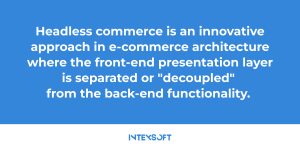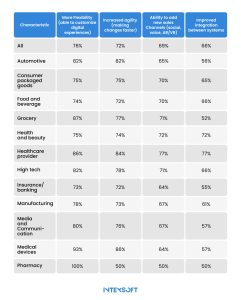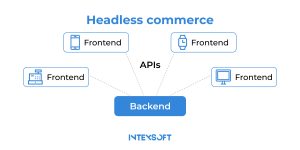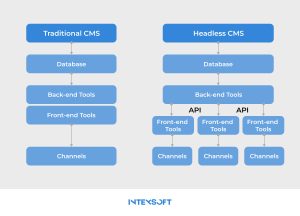Transforming eCommerce: The Advantages and Challenges of Headless vs. Traditional Platforms

In this article, you will learn about enterprise headless commerce platforms compared to traditional ones. We will provide current statistics, deeply uncover the pros and cons for businesses, and highlight key benefits in the long run. Have questions? Get a free consultation from our experts.
Reading time: 19 min.
The rise of such platforms is one reason why a shift is underway in e-commerce. This information is especially meaningful for every store owner who wants to keep their business standing tall. And you will understand why.
Headless commerce development is closely connected with a departure from traditional architectures, where the front-end and back-end were tightly intertwined. Picture this: in the old model, every tweak to the user interface sent ripples through the entire system, stifling creativity and adaptability. But now, the situation has drastically changed.
Let’s delve into the definition of headless commerce.

As a result, developers can leverage the freedom to sculpt dynamic user interfaces without disrupting the backend machinery. This leads to agility, not just aesthetics. Your business gains a strategic advantage: swift responses to market shifts, experimentation with innovative features, and tailoring experiences to individual client preferences.
At the heart of this transformation are APIs, acting as facilitators for seamless communication between front-end interfaces and backend systems. This connectivity unlocks a world of possibilities. For example, businesses can craft immersive experiences across diverse digital touchpoints—from traditional websites and mobile apps to emerging channels (smart speakers and IoT devices).
What’s truly captivating about headless commerce is its forward-looking nature. It positions businesses on the cutting edge, ready to embrace emerging technologies and consumer behaviors. Designers and marketers have more power to weave compelling narratives that resonate with clients.
Look at the stats below to assess the benefits of headless commerce across different industries:


Headless ecommerce Content Management System (CMS) has two key elements: the Application Programming Interface (API) and microservices. These components dictate the intricate maneuvers across a spectrum of channels, ranging from mobile apps to third-party platforms.
The unified interface’s prime role resides in the cloud and is rooted in the realm of Software as a Service (SaaS). This interface serves as the nexus, where updates orchestrated through RESTful APIs, plugins, or a hybrid approach, resonates across multiple digital avenues.
Imagine a bustling online retail emporium leveraging this sophisticated CMS. Through its API prowess, this system seamlessly integrates with a bespoke mobile application, granting customers seamless browsing and transaction experiences. Concurrently, the CMS’s microservices manage inventory logistics, order fulfillment, and secure handling of client data.
Similarly, imagine a media conglomerate utilizing this headless CMS to disseminate content across a myriad of platforms—from traditional websites to cutting-edge smart devices. The API-driven distribution mechanism ensures a harmonious content flow, upholding consistency and quality standards throughout the digital landscape.
In traditional ecommerce platforms, there exists a tightly woven connection between the front-end and back-end functionalities. Picture a scenario where altering the visual layout of your online store directly impacts how data is processed during a customer’s checkout journey. This intricate linkage often results in unforeseen consequences. For example, modifying product categories could unexpectedly alter the search mechanism, leading to confusion.
To mitigate such challenges, traditional platforms provide standardized templates for the front-end interface. These templates are akin to pre-set molds, ensuring that fundamental operations—product display and payment processing—remain intact. While this approach facilitates streamlined website management, it inherently restricts the scope for crafting distinctive user experiences. Moreover, minor adjustments (color schemes or typography choices) can be executed without delving into complex coding, offering a degree of customization within predefined boundaries.
Now, it’s time to delve into the nuances of traditional and headless commerce platforms, highlighting their primary strengths and weaknesses. We will present this information using tables for clarity.
| Key Pros of Traditional Commerce | Explaining |
| Easier Setup and Implementation | Swiftly establishing an online presence hinges on ready solutions. Pre-built templates and integrations streamline setup, rendering it accessible even to those lacking advanced coding prowess. |
| Integrated Content Management System | The built-in CMS simplifies content management tasks, enabling quick updates and adjustments without technical assistance. User-friendly drag-and-drop editors empower non-technical users to modify content layouts, optimize for SEO, and quickly launch marketing campaigns. |
| Extensive range of plug-ins and integrations | Merchants can bolster their eCommerce platforms with a myriad of plug-ins and integrations, spanning from payment gateways to marketing tools and accounting systems. These additions amplify functionality and offer a range of customization options. |
| Scalability and Growth Potential | Traditional commerce platforms offer scalable solutions, enabling businesses to expand their online operations seamlessly as they grow. This scalability encompasses managing larger product catalogs, handling increased order volumes, and accommodating growing customer bases. Businesses can response to new market demands and capitalize on seasonal trends. |
| Reliable Performance and Security | Traditional commerce platforms prioritize performance optimization and stringent security measures. These include robust hosting infrastructure ensuring reliable service, uptime guarantees for uninterrupted operations, data encryption for enhanced security, and adherence to industry standards for compliance. |
| Key Cons of Traditional Commerce | Explaining |
| Restricted design choices | Within predefined templates and features, crafting a distinctive appearance becomes quite challenging. To surpass these confines demands a level of technical expertise. |
| Issues with Personalizing User Experience | Crafting a personalized shopping experience comes with its share of obstacles. Implementing innovative alterations to website aesthetics or offering tailored product suggestions requires effort. Your options are primarily limited to the platform’s capabilities unless you possess adeptness in customization techniques. |
| The Need for Platform Provider Reliance | Your reliance on the platform provider for updates and features is substantial. Altering or switching elements of your website can become intricate endeavors. Should the provider alter a feature you heavily depend on, adapting without significant alterations or platform migrations can pose challenges. |
| Key Pros of Headless Commerce | Explanation |
| Customization for Conversions | Headless commerce liberates businesses from the constraints of traditional monolithic architectures, empowering them to craft tailored user experiences aligned with their unique needs and client preferences. This flexibility not only fosters user engagement but also translates into higher conversion rates, bolstered by personalized interactions and targeted marketing fueled by centralized customer data. |
| Omnichannel Consistency | The hallmark of successful commerce lies in delivering a consistent experience across every customer touchpoint. Headless commerce excels in this domain, offering a seamless omnichannel experience that reinforces brand identity, fosters customer loyalty, and elevates overall user satisfaction, thus solidifying businesses’ market presence and competitiveness. |
| Seamless Integrations | Powered by an API-driven architecture, headless commerce streamlines communication and integrations within the software ecosystem, resulting in reduced latency, enhanced customer experience, and streamlined administrative processes. This seamless integration capability empowers businesses to leverage third-party solutions. |
| Swift Market Entry | Headless commerce enables rapid adaptability and shorter time-to-market for launching new sites, products, or features, enabling businesses to respond promptly to market trends, customer feedback, and emerging opportunities, thereby securing their position as industry frontrunners. |
| Risk-Free Innovation | Its decoupled architecture minimizes disruptions to backend operations, allowing businesses to conduct extensive testing and innovation, refine aesthetics, optimize page layouts, and tailor offerings. |
| Key Cons of Headless Commerce | Explanation |
| Technical Expertise Required | Operating within a headless architecture requires profound technical proficiency from developers and IT personnel. An excellent knowledge of APIs, microservices, and effective system integrations is necessary. |
| Cost of Development and Maintenance | The development and upkeep of a headless commerce platform can incur substantial expenses, particularly if frequent customizations or updates are essential. These costs encompass development resources, API usage, and ongoing maintenance. |
| Limited Built-In Functionality | Such solutions may have weak points regarding built-in functionalities, necessitating additional tools or custom development. |
| Dependency on Reliable APIs | It heavily depends on APIs to ensure smooth communication between its front and back-end components. Any disruptions or performance issues with APIs can detrimentally impact the platform’s functionality and user experience. |
| Risk of Inconsistent User Experience | Inadequate coordination and design standards may result in inconsistent user experiences across various channels, such as web, mobile, and IoT devices. Upholding consistency demands meticulous design and development practices. |
| Need for Robust Security Measures | The decentralized nature of data flow in headless commerce necessitates security practices to ensure the protection of sensitive data. Consider strong authentication, data encryption, and continuous audits as imperative ways to mitigate risks. |
A similarity between e-commerce and traditional commerce is that both involve transactions of goods or services for monetary value. But they have many differences.
What does headless commerce mean regarding specific aspects, how does it differ from the traditional model, and when should we choose every type?
Headless commerce adopts a decoupled architecture, splitting the front-end from the back-end for enhanced flexibility in design. This means you can update and modify the user interface and backend separately, accelerating innovation cycles and facilitating scalability. For example, imagine upgrading your website’s appearance without affecting its functionality or making changes to the checkout process without disrupting product display.
On the flip side, traditional commerce integrates both front-end and back-end systems. While this setup is straightforward, any changes made may affect other parts of the system, resulting in slower updates and reduced agility. Picture adjusting your website’s layout, which might inadvertently impact how payments are processed, potentially causing delays in adapting to market shifts.

Headless commerce empowers businesses to create highly customized and innovative user experiences, catering directly to individual needs. This includes crafting unique interfaces, personalized content, and interactive features, all of which contribute to compelling and engaging shopping experiences. For instance, imagine a clothing brand offering a virtual try-on feature that allows customers to see how different outfits look on them before making a purchase.
On the other hand, traditional commerce platforms offer limited customization options, often relying on pre-built templates and themes. While these platforms still allow for optimized user experiences, they may lack the same level of creativity and innovation found in headless solutions. An example could be a traditional ecommerce website using standard product pages without interactive elements or personalized recommendations, resulting in a less engaging shopping experience overall.
Headless commerce brings forth a vast array of customization possibilities, granting businesses the freedom to implement distinctive features and functionalities. Developers can craft tailored solutions without the constraints of predefined templates or layouts. As a result, you will gain innovation and uniqueness in the digital storefront. For example, a headless commerce platform might allow a furniture store to integrate a 3D room planner tool for customers to visualize how their products fit in different spaces.
Conversely, traditional commerce platforms face limitations in extensive customizations without proficient coding skills. Making modifications to the platform often demands deeper technical expertise or reliance on third-party plugins and extensions, which can restrict the level of customization achievable. An instance of this limitation could be seen in a traditional ecommerce platform requiring complex coding to integrate advanced product filtering options, limiting the flexibility for businesses to enhance user experience without additional technical resources.
Headless commerce offers an abundance of development flexibility, enabling swift changes, updates, and experimentation. Developers have the freedom to work autonomously on both front-end and back-end elements, leading to quicker iterations and the ability to test new features promptly. For example, a headless commerce platform might allow a fashion retailer to rapidly deploy new product showcase designs without disrupting the checkout process.
Conversely, traditional commerce platforms present restricted flexibility, often necessitating intricate coding for substantial modifications. Updates typically undergo a centralized procedure, resulting in prolonged development cycles and potential hurdles in implementing fresh functionalities. An illustration of this limitation could be a traditional eCommerce platform requiring extensive development time to integrate a new payment gateway or shipping method, delaying the rollout of essential features for online shoppers.
Headless commerce shines in seamlessly supporting multi-channel experiences. Its decoupled architecture simplifies integration with diverse channels like mobile apps, IoT devices, and social media platforms. This ensures a uniform user experience across all touchpoints. For instance, a headless commerce setup enables a retail brand to effortlessly sync its online store with a mobile app, allowing customers to browse and purchase across both platforms.
On the other hand, traditional commerce platforms may need separate integrations for multi-channel support. This can introduce potential inconsistencies in user experiences. Managing various channels within a single platform without robust integration capabilities can be challenging. For example, a traditional eCommerce system may struggle to maintain consistent inventory and pricing information across its website, mobile app, and brick-and-mortar stores, leading to customer confusion and operational hurdles.
As businesses expand or pivot, headless solutions can easily scale horizontally by incorporating new functionalities or integrating with additional services. This scalability doesn’t demand significant architectural changes, allowing businesses to grow seamlessly. For example, an e-commerce platform using headless architecture can effortlessly add new payment gateways, implement advanced analytics tools, or integrate with emerging technologies like augmented reality without disrupting its core operations.
Traditional commerce platforms are also scalable but may require more resources and effort for expansion. Scaling a traditional platform typically involves upgrading hardware, optimizing software, and handling increased website traffic. These processes can be time-consuming and costly compared to headless approaches, which offer more flexibility and agility in scaling up. For instance, a traditional e-commerce website might need extensive server upgrades and software optimizations to handle a sudden surge in traffic during peak shopping seasons, whereas a headless platform can adapt more dynamically to such changes.
An online retailer using headless architecture can introduce a new checkout process or launch a targeted promotional campaign much faster compared to a traditional platform.
The integrated structure of traditional platforms can lead to extended development cycles, particularly for intricate functionalities or customizations. For example, a traditional e-commerce platform might take longer to integrate a new payment gateway or update its user interface due to the interconnected nature of its front-end and back-end systems.
Headless commerce may demand higher upfront costs owing to its customization capabilities, yet it offers potential savings in maintenance expenses. The incorporation of microservices, cloud hosting, and modular development can lead to reduced long-term costs and improved scalability. For instance, a business opting for headless commerce might invest more initially in customizing its platform but could save on maintenance and scalability in the long run due to these modern infrastructure options.
Traditional commerce typically involves lower initial setup expenses, but ongoing maintenance and updates could result in higher costs. Customizations, integrations, and scaling endeavors on traditional platforms may lead to increased operational expenses over time, particularly as the business expands. For example, a company using a traditional e-commerce platform might experience rising costs as it integrates more third-party tools, customizes its platform, and manages increasing customer volumes.
Now, you already know what is a headless ecommerce platform, the pros and cons, critical information on traditional commerce platforms, and many aspects of headless commerce development.
Weigh factors—business complexity, customization needs, scalability, development skills, time-to-market goals, and cost implications— and you will make a well-informed decision. If you have questions, our experts will help. Contact IntexSoft anytime.